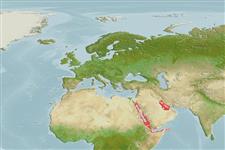Common names from other countries
Environment: milieu / climate zone / depth range / distribution range
экология
морской; солоноватоводный ассоциированный с рифами; пределы глубины 1 - 30 m (Ref. 89707). Tropical; 31°N - 9°N, 32°E - 55°E (Ref. 5222)
Western Indian Ocean: known only from the Red Sea and Gulf of Aden (Ref. 5222). Reported from Somalia and Socotra (Yemen).
Size / Вес / Возраст
Maturity: Lm ? range ? - ? cm
Max length : 52.0 cm TL самец/пол неопределен; (Ref. 9710); common length : 40.0 cm TL самец/пол неопределен; (Ref. 5450)
колючие лучи спинного плавника (общее число) : 11; членистые (мягкие) лучи спинного плавника (общее число) : 14 - 16; колючие лучи анального плавника: 3; членистые (мягкие) лучи анального плавника: 8 - 9. Body robust. Serrae at the angle of the preopercle slightly enlarged; the upper edge of the operculum strongly convex. Posterior nostril of adults vertically elongate. Very similar to E. ongus which has longer pectoral fins, and a narrow white margin with broad blackish submarginal band on the median fins, which are absent or poorly developed in E. summana. Generally dark olive-brown to dark brownish gray with large pale blotches (most larger than the eye) and numerous small white spots overlying this pattern. Fins covered with small white spots, except for pectoral fins where the white spots are confined to the base.
Occurs in shallow protected coral reefs and in lagoons or brackish-water environments (Ref. 5222). No published information on the biology of this species has been found (Ref. 5222). Sold fresh in local markets (Ref. 5222).
Life cycle and mating behavior
Maturities | размножение | Spawnings | Egg(s) | Fecundities | личинки
Heemstra, P.C. and J.E. Randall, 1993. FAO Species Catalogue. Vol. 16. Groupers of the world (family Serranidae, subfamily Epinephelinae). An annotated and illustrated catalogue of the grouper, rockcod, hind, coral grouper and lyretail species known to date. Rome: FAO. FAO Fish. Synop. 125(16):382 p. (Ref. 5222)
Статус Красного Списка МСОП (Ref. 130435)
CITES (Ref. 128078)
Not Evaluated
Угроза для людей
Harmless
Использование человеком
рыболовство: не имеет хозяйственного значения
дополнительная информация
инструменты
Специальные отчеты
Скачать в формате XML
ресурсы в Интернет
Estimates based on models
Preferred temperature (Ref.
115969): 25.1 - 29.3, mean 28.6 (based on 150 cells).
Phylogenetic diversity index (Ref.
82804): PD
50 = 0.5000 [Uniqueness, from 0.5 = low to 2.0 = high].
Bayesian length-weight: a=0.01175 (0.00571 - 0.02419), b=3.04 (2.88 - 3.20), in cm Total Length, based on LWR estimates for this Genus-body shape (Ref.
93245).
Trophic level (Ref.
69278): 3.8 ±0.6 se; based on size and trophs of closest relatives
устойчивость к внешним воздействиям (Ref.
120179): средний (среднего размера), минимальное время удвоения популяции 1.4-4.4 года (Preliminary K or Fecundity.).
Fishing Vulnerability (Ref.
59153): Moderate vulnerability (41 of 100).
Climate Vulnerability (Ref.
125649): Very high vulnerability (83 of 100).
